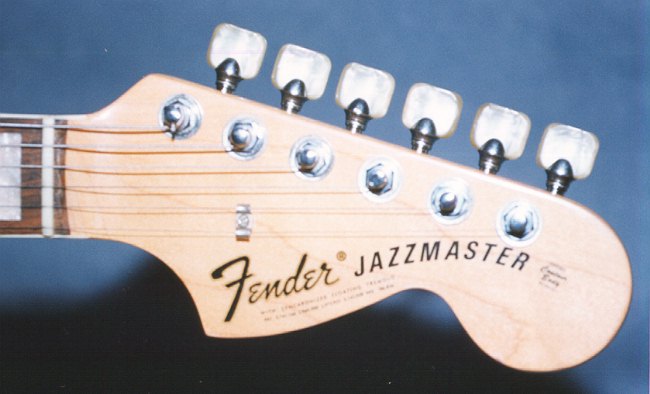Jazzmaster Morphology: Late 1960’s Orphans
by Greg Gagliano – Copyright 1996, 20th Century Guitar Magazine
Much has been written about the inception of the Fender Jazzmaster with its notable changes up to 1966. However, it is necessary to summarize these features to give some perspective to the Jazzmaster of the late 1960’s. The earliest Jazzmasters (prototypes) had small, Stratocaster-like headstocks and fretted maple necks. The headstock shape quickly changed to the familiar large style and remained unaltered from 1958 through 1967. Other well known modifications included the change from anodized to nitrate pickguard (late 1959), nitrate to plastic pickguard (early 1965), spaghetti logo to transition logo (mid-late 1964), Strat style knobs to “amp” style knobs (circa 1964-65), Kluson tuners to Fender tuners (late 1965), slab rosewood board to veneer board (1962), unbound fingerboard with clay dot markers to pearloid dots (late 1964), bound board with pearloid dots (late 1965) and bound board with pearloid block markers (mid 1966).
However, the Jazzmaster continued its metamorphosis in 1968. Starting with the body, construction went from 2-piece to 3-piece alder (and occasionally 4-piece), although 3-piece bodies can be found as far back as late 1966. Polyester lacquer was used in place of nitrocellulose giving the Jazzmaster a slick appearance. This finish, which looks and feels excellent, should not be confused with the thick, plastic-like finishes found on mid to late 1970s Fenders. The color of the tortoise pickguard changed from red with white chunks and some black swirls to a brown-red that contained more black swirls and fewer white chunks. The neck profile of the 1968-69 Jazzmasters remained unchanged from the bound/block marker necks introduced in 1966. However, Fender did offer a maple cap fretboard with black binding and block markers during this time (see Gruhn and Carter, p131).
Examining the headstock reveals a host of changes. As on most Fenders, the gold transition logo was changed to the black CBS logo by late 1967/early 1968. The swoopy Jazzmaster moniker with motion lines changed to a larger bold block letter style around this time also. Sometime in mid-1967, the headstock was modified from the traditional large shape to the shape used on post-1965 Stratocasters. These changes are clearly illustrated in the photographs. Note that the 1962 model headstock is nearly straight as you follow the outline from the just below the rounded top portion to the “point”. By comparison, the headstock on the 1968 model is curved in this area. The 1969 headstock is a bit more trim with a less pronounced or protruding “point”. The difference is subtle and was confirmed by measuring and comparing headstock dimensions on the two guitars. This trimmer headstock has also been observed on Jazzmasters as far back as late 1967 indicating that the slight difference in shape may have been due to variation in production.

In addition, a somewhat surprising feature is also found on these two particular Jazzmasters. Both the 1968 and 1969 models have factory installed pearl button Fender/Grover tuners. These tuners were standard on the Fender Wildwood Coronado series, LTD and Montego guitars. Normally, 1968-69 Jazzmasters were equipped with the standard Fender “F”-tuners with diagonal-cut backs. There is no mention of the Grover tuners being a factory option in the 1968-69 Fender catalog. It is plausible that Fender installed them on a custom basis, regardless of whether or not it was an “official” option. However, the fact that these tuners could be special ordered on the Jazzmaster was not widely known by the public at the time. If it was widely known, there certainly would be more Jazzmasters around today with factory installed Grovers since they are far superior to the standard “F”-tuners. These are the only two Jazzmasters with Grover tuners known to exist by the author, however that does not imply that other examples are not extant. One wonders if these tuners were optional on the Jaguar and/or Stratocaster, as well.
The post-1967 Jazzmasters are fine instruments and offer a viable and affordable alternative to earlier models. Unfortunately, Fender guitars and basses, including the Jazzmaster, began to suffer from quality control and materials problems beginning in late 1966. It is still far easier to find a “good” Fender instrument from the 1966-69 period compared to mid to late 1970s Fenders. Perhaps it is the inconsistent quality (or the polyester lacquer!) that steers collectors away from the 1968-69 Jazzmaster. Maybe it’s just that there aren’t many on the market because there weren’t many Jazzmasters produced in 1968 and 1969 in the first place.
Special thanks to Mr. Dennis Kimball for providing me with photos and information for his 1968 Jazzmaster. Dennis and I spent quite a bit of time on the phone comparing notes and this article would not have been possible without his time and support.
About the author: Mr. Gagliano, a research biologist and part-time bassist, is an avid fan of early CBS era Fenders, G&Ls and Guilds.
Visit GGJaguar’s Homepage


